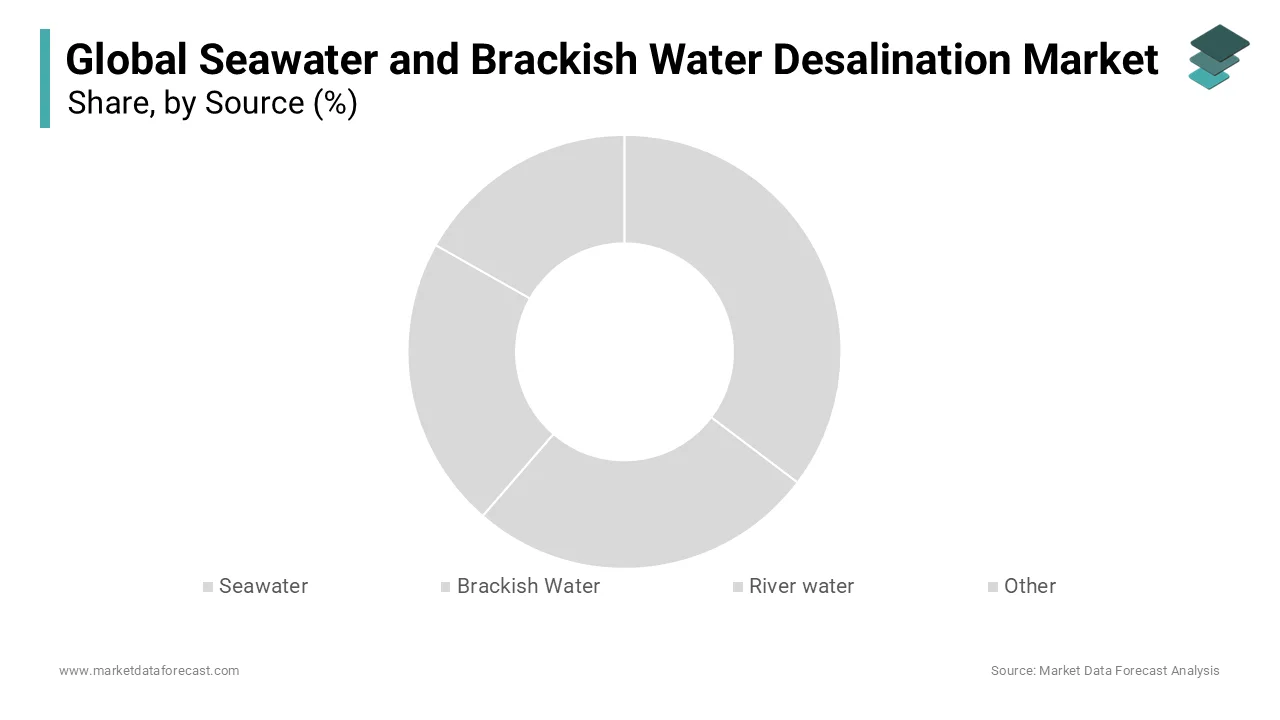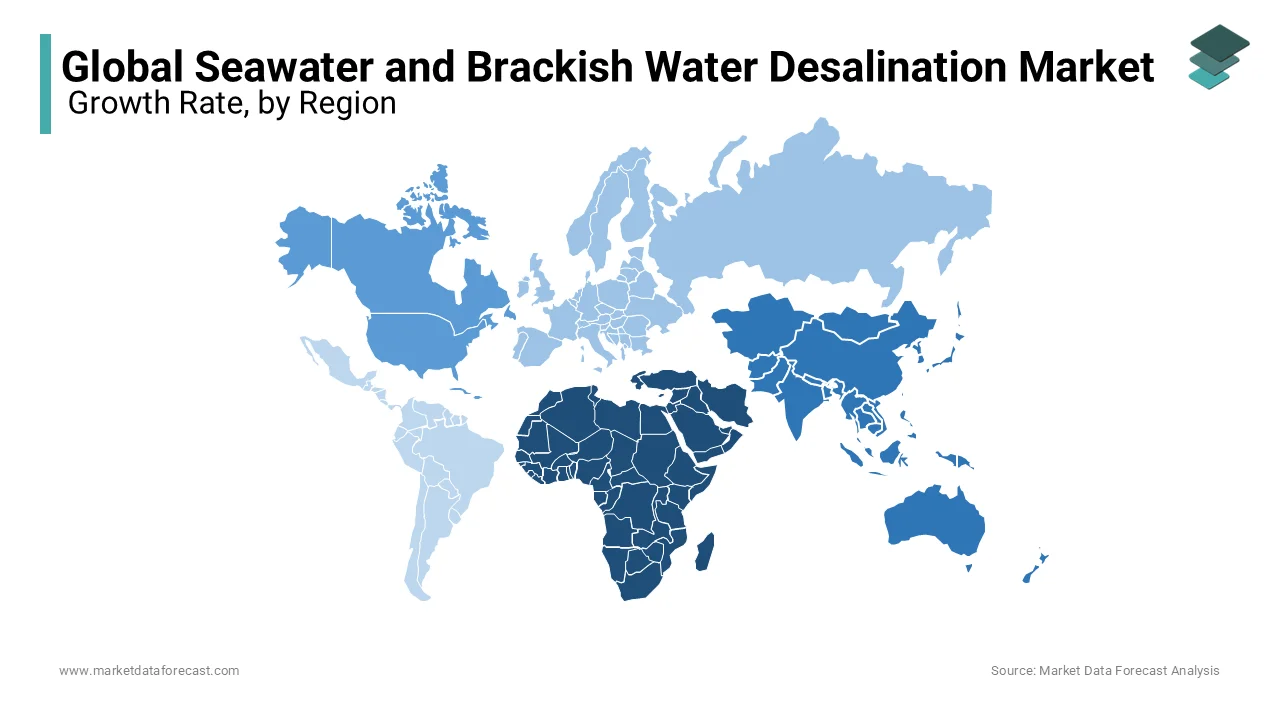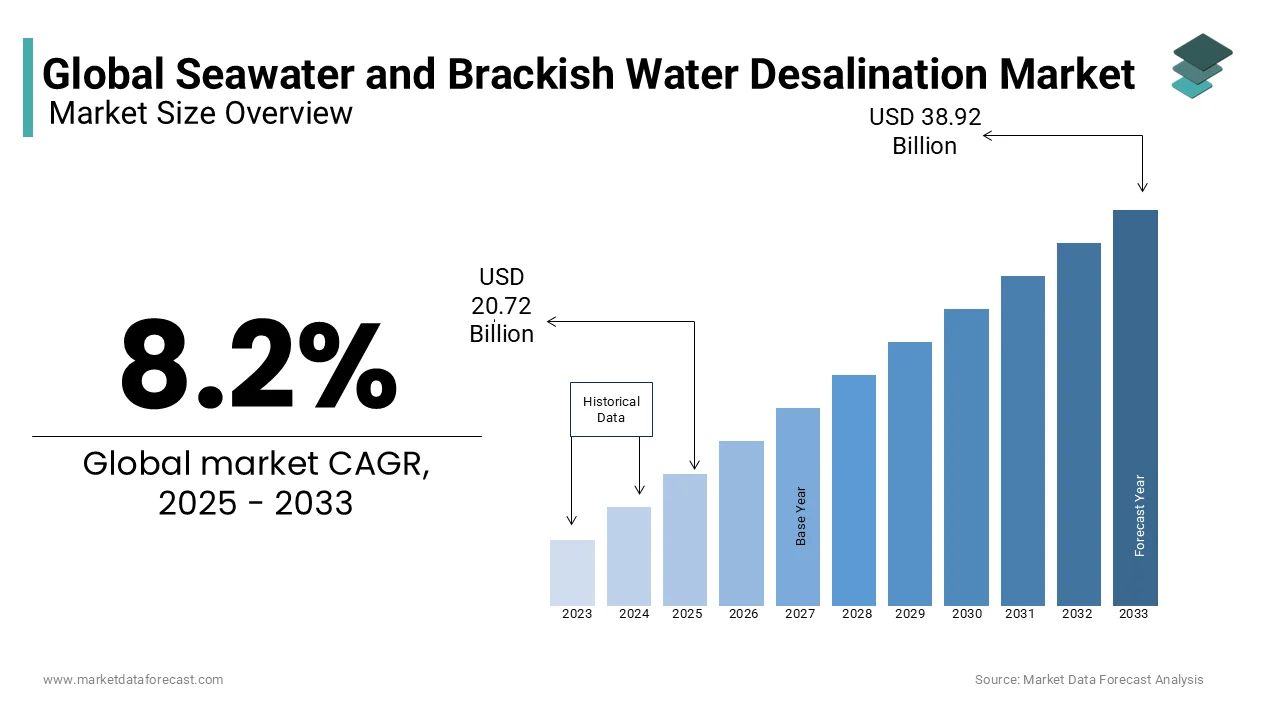Global Seawater and Brackish Water Desalination Market Size, Share, Trends, & Growth Forecast Report By Source (Seawater, Brackish Water, River water, Other), Type ((Thermal Desalination, Multi-stage Flash Distillation (MSF), Multi-effect Distillation (MED), Vapor Compression Distillation (VCD)), (Membrane Desalination, Reverse Osmosis (RO), Electrodialysis (ED), Electrodialysis reversal (EDR)), Application (Municipal, Industrial, Others), & Region, Industry Forecast From 2024 to 2033
Global Seawater and Brackish Water Desalination Market Size
The size of the global seawater and brackish water desalination market was worth USD 19.15 billion in 2024. The global market is anticipated to grow at a CAGR of 8.2% from 2025 to 2033 and be worth USD 38.92 billion by 2033 from USD 20.72 billion in 2025.
Currently, there is an increasing wave of desalination factories worldwide to address the water shortage. With an astonishing 16000 plants all over the globe, this technology is progressively being taken advantage of to ensure the supply of fresh water for coastal and arid regions. However, routinely, these water facilities produce a splendid quantity of brine, which is 142 million cubic meters or 5 billion cubic feet, crossing the previous projections by around 50 percent. In the last few years, nations have been making use of their marine resources sincerely as they want solutions to freshwater scarcities via desalination procedures. This transition is spearheaded by countries such as the United Arab Emirates (UAE) and Saudi Arabia, where the availability of fresh drinking water is scarce. These economies hold about 55 percent of the complete brine output globally.
MARKET DRIVERS
The development of a portable desalination unit drives the growth.
The development of a portable desalination unit that does not require any high-pressure pumps or filters to remove particles drives the growth of the seawater and brackish water desalination market. Likewise, research workers from MIT in April 2022 have devised a portable unit for desalting water weighing under 10 kg and is a suitcase-sized device which consumes electricity less than a mobile phone charger. It can also be operated by a compact and lightweight solar panel and this system even surpasses the quality standards set by the World Health Organisation. The overall unit costs about 50 dollars.
The market is also propelled by the high number of extremely high water-stress countries which is directing and raising investments to present any solution via this approach. According to data published in August 2023, there are more than 25 countries as of now that are vulnerable to extremely high water stress yearly. This shows all these nations utilize more than 80 percent of their sustainably available water resources for domestic, industry, livestock, and irrigation demands. This scenario has already been witnessed in economies like South Africa, Mexico, Iran, India and England.
The mounting need for fresh water is surging the significance of the seawater and brackish water desalination market. As per the study, up to 4 billion people are prone to water scarcity situations for not less than one month annually. Also, the rapid pace of fading away and degrading of the natural ecosystems gives clean water and relieves floods and other hazards like wetlands, mangroves and forests. Besides this, it is predicted that by 2050 the need for water will rise by up to 30 percent, and, at the same time, political uncertainty and water-related conflicts are experiencing an upward trajectory, with climatic variations making it worse.
MARKET RESTRAINTS
The advancement and mass production of portable or next-generation systems for this purpose is restricted by the application of expensive materials. This is one of the factors affecting the seawater and brackish water desalination market growth. Moreover, the formation of crystals quickly after being left is another issue whenever there is any effort to develop new and innovative solar-based desalination systems. Some successful solutions were also made to mitigate this but the rate of desalinating water reduced. Additionally, a serious issue is the elimination of brine waste. This saline-heavy residue can obstruct oceanic or coastal ecosystems if not good governance. The environmental consequences of desalination plants, especially those situated beside coastlines, are a major problem for water treatment engineers and ecological consultants.
MARKET OPPORTUNITIES
The use of low-cost materials instead of expensive ones in the portable system based on filer-free technology holds immense opportunity for the seawater and brackish water desalination market. Moreover, the market is also expected to grow with further development and application of the ion concentration polarization (ICP) technique. This technique as of now works with electrodialysis as demonstrated by Prof. Jongyoon Han in its development at MIT in April 2022. Apart from this, Chinese and MIT engineers are targeting to produce drinking water from seawater with a fully passive device which is powered by the sun and influenced by the ocean. The design of a new solar desalination system has already been prepared by the team. Also, the novel device has a greater rate of salt rejection as well as water production compared to all other solar-based passive desalination concepts presently undergoing tests. Hence, all these developments are boosting the market growth rate.
MARKET CHALLENGES
The seawater and brackish water desalination market growth is derailed by the toxic impacts of brine. The production of brine has elevated because of greater dependence on desalination procedures in nations such as Qatar, United Arab Emirates (UAE) and Saudi Arabia which add around 55 per cent towards overall worldwide brine output yearly. Apart from the amplified salinity levels impacting oceanic temperature laws, there is high certainty that bio-accumulation under marine organisms can take place owing to the presence of pollutants and heavy metals within unprocessed brines. This may result in prolonged deterioration at both the single species level together with wider ecological dynamics if not managed accountably. Hence, decreasing the market growth rate.
REPORT COVERAGE
|
REPORT METRIC |
DETAILS |
|
Market Size Available |
2024 to 2033 |
|
Base Year |
2024 |
|
Forecast Period |
2025 to 2033 |
|
CAGR |
8.2% |
|
Segments Covered |
By source, type, application, and region. |
|
Various Analyses Covered |
Global, Regional & Country Level Analysis, Segment-Level Analysis, DROC, PESTLE Analysis, Porter’s Five Forces Analysis, Competitive Landscape, Analyst Overview of Investment Opportunities |
|
Regions Covered |
North America, Europe, APAC, Latin America, Middle East & Africa |
|
Market Leaders Profiled |
Abengoa, ACCIONA, Veolia, Doosan Heavy Industries & Construction, Siemens, IDE Technologies, Koch Separation Solutions, Suez, Koch Separation Solutions, CleanBay Renewables, Evoqua Water Technologies, Dow, Aquatech International, Genesis Water Technologies, and Others. |
SEGMENT ANALYSIS
By Source Insights
The seawater segment remained the most prevalent source and holds a significant market share. This can be attributed to the sharp drop in the water levels in freshwater resources and the escalating need for potable water has resulted in a supply shortfall. Moreover, seawater represents a source that exists in abundance on the globe, positioning as a highly dependable resource over the estimation period. The breakthroughs in technologies to raise the gain-to-output proportion of potable water from seawater will propel the growth of the segment’s market share. For instance, the government of Morocco is supporting a shift to non-traditional water sources, like desalinating seawater or the reapplication of processed wastewater as a feasible strategy to expand the availability of water supply and deliver a trustworthy source of freshwater free of rainfall trends.

By Type Insights
The reverse osmosis (RO) segment spearheaded this category of the seawater and brackish water desalination market. The affordable and simple use nature of reverse osmosis is mainly contributing to the expansion of its market share. RO maintains the application of chemicals to the lowest, an added advantage propelling the segment's market size. Moreover, the increase in technological breakthroughs has accelerated the rising dependence on desalinization methods. Also, RO, the most frequently employed technique is praised not only for its productiveness but also its effectiveness. It fulfills both the demands of industrial users needing filtered water coupled with facilitating drinkable water for societies, cities, and towns. In addition, reverse osmosis is the most comprehensive and sophisticated desalination system in the world and is utilised in more than 60 per cent of facilities globally.
By Application Insights
The municipal is the biggest user of the seawater and brackish desalination market. Considering the growing population world population, urbanization and migration to urban regions, the segment’s market share is expected to increase in the coming years. The shortage of water sources has obligated more water treatment and recycling facilities. Besides this, municipal wastewater is normally treated to meet the legal demands for release to ecological waters. However, there is surging employment of wastewater reapplication initiatives. The considerable pollutants necessitating elimination from municipal wastewater, usually in the order of significance, include solid materials suspended, natural substances, micro-pollutants, pathogenic bacteria, phosphate and nitrates.
REGIONAL ANALYSIS
The Middle East and Africa region currently leads the seawater and brackish water desalination market because of the rising population of Qatar, Oman, Lebanon, Kuwait, Cyprus and Bahrain which are also the most water-stressed nations. This can be attributed to the refugee extremity in this region, and growing government spending on reconstruction, upgrading and supply chain infrastructure. Moreover, the construction industry consumes water in huge quantities, which will improve the region’s market size.

The Asia Pacific region is anticipated to expand over the estimation period owing to the escalating water shortage, along with rising demand because of swift urbanization. According to a study, failing to enforce superior water programs or initiatives for water management could lead to losses in GDP of 7 per cent to 12 per cent for China, Asia and Central Asia.
KEY PLAYERS IN THE MARKET
Companies playing a prominent role in the global seawater and brackish water desalination market include Abengoa, ACCIONA, Veolia, Doosan Heavy Industries & Construction, Siemens, IDE Technologies, Koch Separation Solutions, Suez, Koch Separation Solutions, CleanBay Renewables, Evoqua Water Technologies, Dow, Aquatech International, Genesis Water Technologies, and Others.
RECENT HAPPENINGS IN THE MARKET
- In May 2024, research personnel from The Australian National University submitted a new technique for desalinating water which evades several of the unnecessary adverse effects of conventional desalinating methods and lowers the power needed by around 80 per cent.
MARKET SEGMENTATION
This research report on the global seawater and brackish water desalination market has been segmented and sub-segmented based on source, type, application, and region.
By Source
- Seawater
- Brackish Water
- River water
- Other
By Type
- Thermal Desalination
- Multi-stage Flash Distillation (MSF)
- Multi-effect Distillation (MED)
- Vapor Compression Distillation (VCD)
- Membrane Desalination
- Reverse Osmosis (RO)
- Electrodialysis (ED)
- Electrodialysis reversal (EDR)
By Application
- Municipal
- Industrial
- Others
By Region
- North America
- Europe
- Asia Pacific
- Latin America
- Middle East & Africa
Frequently Asked Questions
What is desalination, and why is it important?
Desalination is the process of removing salts and other impurities from seawater or brackish water to make it potable. It is crucial for providing fresh water in regions facing water scarcity due to arid climates, population growth, or limited freshwater resources.
What are the main types of desalination technologies?
The primary technologies include Reverse Osmosis (RO) and Multi-Stage Flash (MSF) distillation. RO uses semi-permeable membranes to filter out salts, while MSF involves heating water to produce steam, which is then condensed into freshwater.
Which regions are driving the demand for desalination?
Due to their arid climates and increasing water needs, the Middle East and North Africa, along with parts of Asia and the United States, are leading the demand.
What are the environmental concerns associated with desalination?
Desalination can lead to environmental issues such as brine discharge, which can harm marine ecosystems, and high energy consumption, contributing to carbon emissions.
What is the future outlook for the desalination market?
The market is expected to grow, driven by technological advancements, declining costs, and the increasing need for sustainable water sources in water-scarce regions.
Related Reports
Access the study in MULTIPLE FORMATS
Purchase options starting from $ 2500
Didn’t find what you’re looking for?
TALK TO OUR ANALYST TEAM
Need something within your budget?
NO WORRIES! WE GOT YOU COVERED!
Call us on: +1 888 702 9696 (U.S Toll Free)
Write to us: [email protected]
